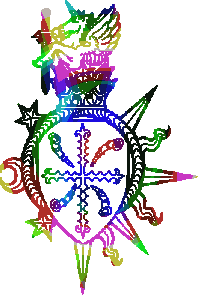

The Gypsies: The groups of people known as the gypsies migrated from Northern India a bit over one thousand years ago. At least, this is determined from linguistic analysis of Romany, their language, which seems to have split from the Indo-European languages of Northern India in the 9th or 10th century AD. They had migrated to Persia by the 11th century, and were in Southeast Europe by the 14th. Less than a century later, they were all over Europe. In modern times, the gypsies can be found in North and South America as well as Australia.
Due to their traveling ways, the gypsies made marvelous scapegoats for the churches and governments of Europe to persecute. This continues into modern times. In fact, the gypsies were among those targeted during the Holocaust. There were an estimated 400,000 gypsies killed by the Nazis in World War II. French laws forbid the gypsies from establishing campsites and subject them to mandatory supervision.
Another reason for their poor treatment at the hands of others regards their attitudes of non-gypsies, or "gadje." This word generally means outsider, but also encompasses bumpkin, yokel, barbarian, and a few others less complimentary. This sums up their general attitude toward those not of their group. Of course, the way they're generally treated tends to vindicate their viewpoint.
Since nothing in life is free, the gypsies must often work to make ends meet. There is a division of labor along gender lines. The men tend to be livestock traders, animal trainers, exhibitors, tinkers and musicians. Women sell potions and tell fortunes. These divisions are fairly rigid. In modern times, tinkers are not so important or necessary, so the men often become mechanics instead. Many are employed in traveling circuses.
There are three basic tribal groupings of gypsies:
The Kalderash are the most numerous. They are from the Balkans and Central Europe. They are best known for being smiths, tinkers, mechanics.
The Ravnos as described in the Player's Guide are the original Ravnos, the Clan as it existed before the Gypsies began wandering as they do now. However, with the diaspora across Europe, different groups chose different specializations. In a mirror to this, the Ravnos who come from each of these groups have split a bit from the baseline, and as such have the following differences:
Kalderash Ravnos: The Disciplines are Auspex, Chimerstry, Fortitude. Concepts tend to be Dilettante, Outsider, Working Man, Criminal.
Additional Philosophical Material
The original Gypsies came from Northern India, making the original stock Indo-Aryan. The Goddess Kali, in her aspect as death, is associated with the color red. Death and red are also closely associated by the gypsies.
Compare the Path of Paradox, and the Discipline Chimerstry with writings on Kali, Shakti, Maia, and any other Indo-Aryan goddess you can name. You will find some surprising similarities. I tend to think that the original Ravnos followed the concepts of Maia, in fact. "All is Maia, the illusory veil over reality." The coming of the Kali Yuga, when all returns to Chaos without Form. Compare to the Flux.
 The Ravnos are a Clan with a potentially rich history and tradition behind it. Their own background is inextricably entwined with that of the gypsies, and as such have much in common.
The Ravnos are a Clan with a potentially rich history and tradition behind it. Their own background is inextricably entwined with that of the gypsies, and as such have much in common.
The Gitanos range through Iberia, southern France and northern Africa. They are known for being entertainers.
The Manouches (Manush) are generally present in Sinti-France, Alsace and Germany. They are known for being traveling showmen and circus people.
Gitanos Ravnos: The Disciplines are Chimerstry, Obfuscate, Presence. Concepts tend to be Entertainer, Outsider, Criminal.
Manouches Ravnos: The Disciplines are Celerity, Chimerstry, Presence. Concepts tend to be Drifter, Outsider, Entertainer, Criminal.
![[Return to Main Page]](razhome.jpg)